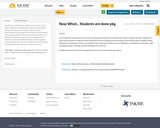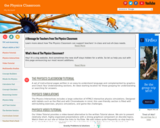
A package to do when you're done your other work.
- Subject:
- Math
- Material Type:
- Assessment
- Date Added:
- 05/01/2019

A package to do when you're done your other work.

"The learning resources created for the numeracy project include:
*a document that identifies a big idea in a curricular outcome, questions for classroom instruction for student assessment, sample answers shown concretely, pictorially and symbolically and connecting outcomes;
*reference documents that provide further information or resources;
*additional questions across multiple grades for each big idea found in a progression document; and,
short videos.
The numeracy project is a curriculum, instruction and assessment support for mathematics. The learning supports are aligned directly to Saskatchewan curricular outcomes."
Select the grade from the menu on the left to explore available documents. I suggest starting by watching the supporting video provided below the documents. The video provides background and information about the documents.
Select Progressions on the menu on the left to explore by theme. (Coming soon)
PLEASE NOTE THAT NEW RESOURCES WILL BE CONTINUED TO BE ADDED HERE THROUGHOUT THE 2022-23 SCHOOL YEAR. CHECK BACK REGULARLY!

The lesson begins by introducing Olympics as the unit theme. The purpose of this lesson is to introduce students to the techniques of engineering problem solving. Specific techniques covered in the lesson include brainstorming and the engineering design process. The importance of thinking out of the box is also stressed to show that while some tasks seem impossible, they can be done. This introduction includes a discussion of the engineering required to build grand, often complex, Olympic event centers.

The following file contains the assets (or resources) to accompany the Sask DLC Mathematics Foundations 20. Please note that this is not the content of the course, but the assets used to support and deliver it. The files are organized in a zipped folder. You can download it and extract the files. Links are also provided to other materials like videos and other suggested resources.

The following file contains the assets (or resources) to accompany the Sask DLC Workplace & Apprenticeship Mathematics 10. Please note that this is not the content of the course, but the assets used to support and deliver it. The files are organized in a zipped folder. You can download it and extract the files. Links are also provided to other materials like videos and other suggested resources.

Get DEEPER Math learning from your students. Get them thinking.
Grades K-12
Worksheets and THINKING activities are organized by strand on the right side of the website.
There is a great worksheet called "Open Middle Worksheet" on the top right for kids to document their process for problem solving. It gives them up to 6 attempts and the ability to explain what they have learned and how they need to change their approach for the next attempt.
This site accompanies the book "Open Math" by Robert Kaplinsky, but you do NOT need the book to benefit from these excellent questions.
Click "Get Our Favorite Problems" to get started (you will need to enter your info.) or use the menu organized by grade and strand on the right side of the page.
Free webinars are also recorded and available for elementary and secondary teachers to help "rethink classwork"
Example Question - Grade 3 - How many numbers are there between 1 and 3? (great way to introduce fractions).

This site offers Life Skills Curriculum for Elementary, Middle, and High School.
Overcoming Obstacles is a free, award-winning, and research-based life skills curriculum that provides educators with the tools to teach elementary, middle, and high school students the skills necessary for success. With hundreds of easy to teach activity-based lessons covering more than 30 critical social and emotional skills, students learn how to communicate effectively. They learn how to make informed decisions. They learn how to set and achieve goals, resolve conflicts, solve problems, respect one another, and more

Invasion games: soccer, basketball, football, rugby and hockey.
Target games: golf, archery, bowling, bocce ball, and billiards.
Net/wall games: tennis, volleyball, squash and badminton.
Striking/fielding games: baseball, cricket, softball and kickball.
Chasing & Fleeing Games
Movement Skill Games
Cooperation Games
Health & Fitness Games

A wealth of resources for teaching and learning about physics!
Tutorials, interactives, videos, multimedia info, concept builders, concept checkers, question bank HELP and more!

Students use the free computer game Pingus to learn how engineers, specifically environmental engineers, use their technical writing skills to give instructions and follow the instructions of others. Students learn to write instructions to express their ideas in clear, organized ways using descriptive, un-ambiguous sentences, as an example of one type of technical writing that important for engineers. The students write instructions enumerating how to beat a game level, which represents surveying that level for environmental problems. As a test of their instructions, students review each others' instructions and offer suggestions for improvement, and then revise their instructions to make them better. Students also see some examples of environmental problems.

Precalculus is adaptable and designed to fit the needs of a variety of precalculus courses. It is a comprehensive text that covers more ground than a typical one- or two-semester college-level precalculus course. The content is organized by clearly-defined learning objectives, and includes worked examples that demonstrate problem-solving approaches in an accessible way.

Students apply what they have learned about the engineering design process to a real-life problem that affects them and/or their school. They chose a problem as a group, and then follow the engineering design process to come up with and test their design solution. This activity teaches students how to use the engineering design process while improving something in the school environment that matters to them. By performing each step of the design process, students can experience what it is like to be an engineer.

Students are introduced to a systematic procedure for solving problems through a demonstration and then the application of the method to an everyday activity. The unit project is introduced to provide relevance to subsequent lessons.

From The University of Waterloo:
"Many instructors in engineering, math and science have students solve “problems”. But are their students solving true problems or mere exercises? The former stresses critical thinking and decision-making skills whereas the latter requires only the application of previously learned procedures. True problem solving is the process of applying a method – not known in advance – to a problem that is subject to a specific set of conditions and that the problem solver has not seen before, in order to obtain a satisfactory solution."
Details are provided on the principles of problem-solving as well as each step of the process outlined below:
Define the Problem
Think About it
Plan a Solution
Carry Out the Plan
Look Back

Students learn about the concept of pushing, as well as the relationship between force and mass. Students practice measurement skills using pan scales and rulers to make predictions about mass and distance. A LEGO MINDSTORMS(TM) NXT robot is used to test their hypotheses. By the end of the activity, students have a better understanding of robotics, mass and friction and the concept of predicting.

Students analyze a cartoon of a Rube Goldberg machine and a Python programming language script to practice engineering analysis. In both cases, they study the examples to determine how the different systems operate and the function of each component. This exercise in juxtaposition enables students to see the parallels between a more traditional mechanical engineering design and computer programming. Students also gain practice in analyzing two very different systems to fully understand how they work, similar to how engineers analyze systems and determine how they function and how changes to the system might affect the system.

Working in small groups, students complete and run functioning Python codes. They begin by determining the missing commands in a sample piece of Python code that doubles all the elements of a given input and sums the resulting values. Then students modify more advanced Python code, which numerically computes the slope of a tangent line by finding the slopes of progressively closer secant lines; to this code they add explanatory comments to describe the function of each line of code. This requires students to understand the logic employed in the Python code. Finally, students make modifications to the code in order to find the slopes of tangents to a variety of functions.

Students solidify their understanding of the terms "circumference" and "rotation" through the use of LEGO MINDSTORMS(TM) NXT robotics components. They measure the circumference of robot wheels to determine how far the robot can travel during one rotation of an NXT motor. They sharpen their metric system measurement skills by precisely recording the length of a wheel's circumference in centimeters, as well as fractions of centimeters. Through this activity, students practice brainstorming ways to solve a problem when presented with a given scenario, improve their ability to measure and record lengths to different degrees of precision, and become familiar with common geometric terms (such as perimeter and rotation).

Same But Different is a powerful routine for use in math classrooms. The activity of same but different is an activity where two things are compared, calling attention to both how they are the same and how they are different.
This apparent paradox is the beauty of the activity. It is important to notice the word BUT. Instead of making a choice – am I going to prove that these are the same or am I going to prove that they are different – students are considering how two items can be both. This is a critically important distinction.
Not same OR different, rather same BUT different.
There are categories for addition/subtraction, early numeracy, multiplication/division, measurement, place value, fractions, ratios, geometry, algebra, and high school math.

Open-ended questions to differentiate math instruction.
This is a collection of different types of questions you can use for problem solving that differentiate to meet the varied needs of your classroom.
Some potential number talks are included in the "What one doesn't belong" section.